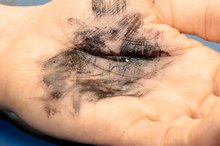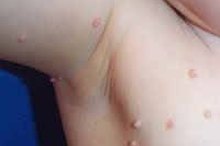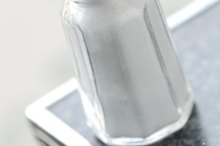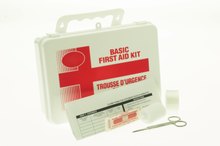What does fact checked mean?
At Healthfully, we strive to deliver objective content that is accurate and up-to-date. Our team periodically reviews articles in order to ensure content quality. The sources cited below consist of evidence from peer-reviewed journals, prominent medical organizations, academic associations, and government data.
The information contained on this site is for informational purposes only, and should not be used as a substitute for the advice of a professional health care provider. Please check with the appropriate physician regarding health questions and concerns. Although we strive to deliver accurate and up-to-date information, no guarantee to that effect is made.
Removing Surgical Iodine From Skin
As a skin sterilizer, sugical iodine preps an area for surgery and eliminates bacteria for the safest and best possible outcome. However, there is one major drawback to the substance: it stains your skin. And though this may seem minor, it can be a nuisance.
Why Is Surgical Iodine Used?
Surgical iodine is used primarily to prepare an area of your skin for surgery. This helps to prevent infections and poor healing following any given procedure. Topical iodine is also used to treat cuts and scrapes in an effort to prevent infection and aid healing 1.
What Iodine Does to the Skin
Foods With No Iodine
Learn More
Iodine is a necessity in the surgical world, but it does have its drawbacks. For instance, some people suffer from a severe reaction to the substance. This can display itself as burning, itching or general irritation. This is relatively rare, however. For most people, their biggest complaint about surgical iodine is how dramatically it stains their skin. Some people are stuck for weeks with amber-colored stains on the surgical site.
- Iodine is a necessity in the surgical world, but it does have its drawbacks.
- For most people, their biggest complaint about surgical iodine is how dramatically it stains their skin.
How to Remove Iodine from the Skin
For the most part, iodine will wash off the skin with plain old soap and water. However, it will only do so gradually, over the course of several weeks. To speed up this process, you can use alcohol. Simply soak a cotton pad or ball in alcohol and rub it on the stained area. The stain should lift up immediately. Be careful to avoid getting the alcohol on the incision site, however, as this can cause serious stinging, burning and irritation.
- For the most part, iodine will wash off the skin with plain old soap and water.
- Be careful to avoid getting the alcohol on the incision site, however, as this can cause serious stinging, burning and irritation.
Related Articles
References
- Iodine (Topical Route)
- Iodine consumer information
- American Thyroid Association. Iodine Deficiency. 2020.
- Eastman CJ, Zimmermann MB. The iodine deficiency disorders. In: Feingold KR, Anawalt B, Boyce A, et al., editors. Endotext. South Dartmouth, MA: MDText.com, Inc. Updated February 6, 2018.
- Ahad F, Ganie SA. Iodine, Iodine metabolism and Iodine deficiency disorders revisited. Indian J Endocrinol Metab. 2010;14(1):13-17.
- Kostoglou-athanassiou I, Ntalles K. Hypothyroidism - new aspects of an old disease. Hippokratia. 2010;14(2):82-87.
- American Thyroid Association. Hypothyroidism in Children and Adolescents. 2020.
- National Institutes of Health, Office of Dietary Supplements. Iodine. Updated July 9, 2019.
- U.S. National Library of Medicine. Congenital hypothyroidism. Updated February 11, 2020.
- Johnson LE. Iodine. Merck Manual Professional Version. Updated October 2018.
- Murthy MB, Krishnamurthy B. Severe irritant contact dermatitis induced by povidone iodine solution. Indian J Pharmacol. 2009;41(4):199-200. doi:10.4103/0253-7613.56069
- Puchalski AR, Chopra IJ. Radioiodine treatment of differentiated thyroid cancer despite history of 'iodine allergy'. Endocrinol Diabetes Metab Case Rep. 2014;2014:130084. doi:10.1530/EDM-13-0084
- Schabelman E, Witting M. The relationship of radiocontrast, iodine, and seafood allergies: a medical myth exposed. J Emerg Med. 2010;39(5):701-707. doi:10.1016/j.jemermed.2009.10.014
- National Institutes of Health, Office of Dietary Supplements. Iodine. Updated July 9, 2019.
- American Cancer Society. Radioactive Iodine (Radioiodine) Therapy for Thyroid Cancer. Updated March 14, 2019.
- Centers for Disease Control and Prevention. Potassium iodide (KI). Updated April 4, 2018.
- Kalra S, Unnikrishnan AG, Sahay R. The hypoglycemic side of hypothyroidism. Indian J Endocrinol Metab. 2014;18(1):1-3.doi:+10.4103/2230-8210.126517
Writer Bio
Brenda Barron is a writer, editor and researcher based in Southern California. She has worked as a writer since 2004, with work appearing in online and print publications such as BabyZone, "Cat Fancy" and "ePregnancy." She holds a Bachelor of Arts in English literature from California State University, Long Beach.








